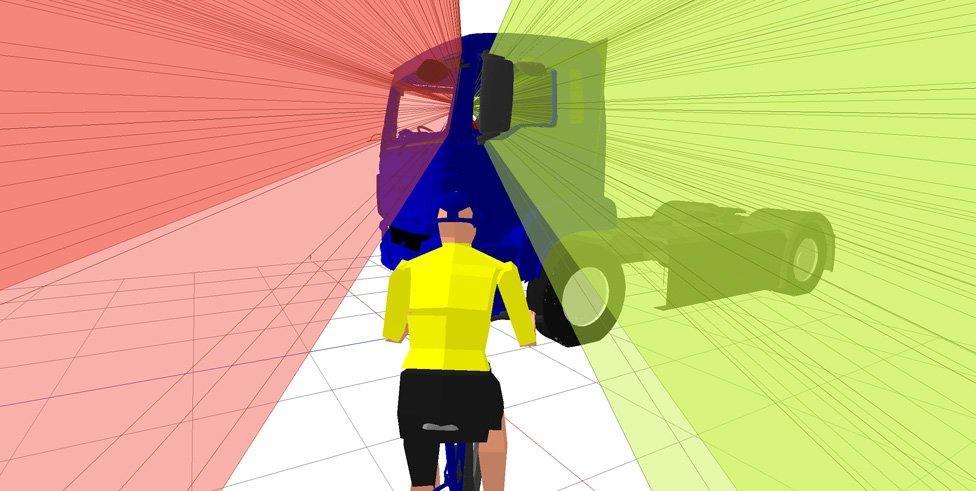Do some lorries have a basic problem with turning left?
- Published
A lorry crashes into a motorbike at a road junction, posted on YouTube by Bigsmokeandthemonster
Dramatic footage of a lorry driver turning into the path of a motorcyclist has been widely shared on social media. Is it possible to prevent accidents like this when heavy vehicles use city streets?
It all happens in a matter of seconds. A lorry driver turns left into a side road.
With the wide turning circle of his vehicle, he ends up in the right hand lane and fails to spot that he is heading straight towards a man approaching the junction on a motorcycle.
The motorcyclist just has enough time get off his Ducati Monster bike before the lorry ploughs into it.
Fortunately no-one was injured in the collision in Peckham, south London. The motorcyclist, the video blogger Bigsmokeandthemonster, external, who filmed the incident on a GoPro camera, acknowledged in a comment on YouTube "how lucky I am to be in one piece".
It's the latest in a series of high-profile collisions involving large vehicles on city streets. The London Cycling Campaign (LCC) says seven of the eight cycling deaths in the capital this year have involved lorries.
There's no suggestion that in this case the lorry driver was acting negligently. Indeed, it appears from the footage that, as he turned, he took pains to avoid his rear wheels mounting the pavement where a woman with a buggy was standing.
"It was the proper manoeuvre," says Melvyn Hodgetts, a former logistics safety director for Royal Mail. "He couldn't have done it any other way." Because this is a rigid vehicle, rather than an articulated lorry with a pivoting joint, the driver has to take a wide left-hand turn so as not to clip the kerb.
However, this takes the lorry into the right-hand lane of the side street. The driver's view of the oncoming motorcyclist appears to be obscured by a combination of the A-pillar - the vertical support between the cab's windscreen and the side window - and the mirrors, says Dr Russell Marshall of Loughborough University.

A graphic shows the blind spot created by the wide turn of an HGV. Graphic: Design Ergonomics Group, Loughborough Design School, Loughborough University
Marshall used projection techniques to estimate the driver's field of view. These suggested the driver can see to either side of the motorcyclist, but the location in which the Ducati is actually positioned appears to be obscured until the point of impact.
"With some very specific positioning the HGV can end up hitting the obscured vulnerable road user without ever being able to see them," says Marshall.
All this raises questions about the appropriateness of using such vehicles in dense city streets. Gary Rae, campaigns manger for road safety charity Brake, said it was "vital that HGV [heavy goods vehicle] drivers are fully alert to vulnerable road users, such as motorcyclists and cyclists and that their vehicles are fitted with the latest safety devices".
The LCC wants lorries to be banned from the capital's streets during rush hour. Similar restrictions are currently in force in Paris and Dublin.
Already the London Lorry Control Scheme confines HGVs to restricted routes at certain times to prevent noise pollution. From September, under the Safer Lorries Scheme, HGVs of more than 3.5 tonnes which are not fitted with appropriate mirrors and side guards will be excluded from the capital's streets.
Marshall says manoeuvres of the kind shown in the video take place all the time without any accidents. But while work is being done by industry to minimise the risk of these occurring, he says, "ultimately, many busy urban areas are just not fully compatible with this kind of vehicle".
However, Hodgetts, who is also campaigns manager for the industry group Driving for Better Business, says new technology could dramatically reduce the risk of accidents. He adds: "What might have prevented this particular incident is automatic emergency braking," - an autonomous safety system that prevents or slows down collisions.
In February HGV cabs designed to reduce blind spots were unveiled, external by a range of manufacturers. EU legislation will require new vehicles to be fitted with improved mirror designs from the end of June 2015. This came after researchers using 3D modelling at Loughborough identified a key blind spot in drivers' lateral vision.
Fortunately for the motorcyclist in the video, on this occasion there were no injuries. The debate about the role of heavy vehicles on city streets will continue.
Subscribe to the BBC News Magazine's email newsletter, external to get articles sent to your inbox.